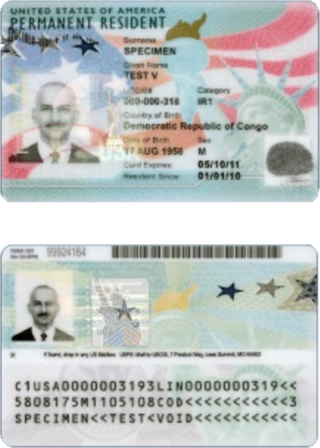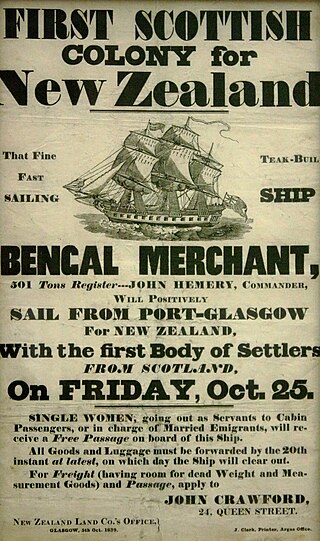
A green card, known officially as a permanent resident card, is an identity document which shows that a person has permanent residency in the United States. Green card holders are formally known as lawful permanent residents (LPRs). As of 2019, there are an estimated 13.9 million green card holders, of whom 9.1 million are eligible to become United States citizens. Approximately 65,000 of them serve in the U.S. Armed Forces.
Australian permanent residents are residents of Australia who hold a permanent visa but are not citizens of Australia. A holder of a permanent visa may remain in Australia indefinitely. A 5-year initial travel facility, which corresponds to the underlying migration program, is granted alongside the permanent visa. Until the travel facility expires, the visa holder may leave and re-enter Australia freely. After that period the visa holder needs to re-apply for the travel facility. However, holders of a permanent visa who are already in Australia with an expired travel facility may remain in Australia indefinitely.

Permanent residency is a person's legal resident status in a country or territory of which such person is not a citizen but where they have the right to reside on a permanent basis. This is usually for a permanent period; a person with such legal status is known as a permanent resident. In the United States, such a person is referred to as a green card holder but more formally as a Lawful Permanent Resident (LPR).

Foreign relations between neighbouring countries Australia and New Zealand, also referred to as Trans-Tasman relations, are extremely close. Both countries share a British colonial heritage as antipodean Dominions and settler colonies, and both are part of the core Anglosphere. New Zealand sent representatives to the constitutional conventions which led to the uniting of the six Australian colonies but opted not to join. In the Boer War and in both world wars, New Zealand soldiers fought alongside Australian soldiers. In recent years the Closer Economic Relations free trade agreement and its predecessors have inspired ever-converging economic integration. Despite some shared similarities, the cultures of Australia and New Zealand also have their own sets of differences and there are sometimes differences of opinion which some have declared as symptomatic of sibling rivalry. This often centres upon sports and in commercio-economic tensions, such as those arising from the failure of Ansett Australia and those engendered by the formerly long-standing Australian ban on New Zealand apple imports.

The Trans-Tasman Travel Arrangement (TTTA) is an arrangement between Australia and the Realm of New Zealand which allows for the free movement of citizens of one of these countries to the other. The arrangement came into effect in 1973, and allows citizens of each country to reside and work in the other country, with some restrictions. Other details of the arrangement have varied over time. From 1 July 1981, all people entering Australia have been required to carry a passport. Since 1 September 1994, Australia has had a universal visa requirement, and to specifically cater for the continued free movement of New Zealanders to Australia the Special Category Visa was introduced for New Zealanders.

Australian nationality law details the conditions by which a person is a national of Australia. The primary law governing nationality regulations is the Australian Citizenship Act 2007, which came into force on 1 July 2007 and is applicable in all states and territories of Australia.

The visa policy of Australia deals with the requirements that a foreign national wishing to enter Australia must meet to obtain a visa, which is a permit to travel, to enter and remain in the country. A visa may also entitle the visa holder to other privileges, such as a right to work, study, etc. and may be subject to conditions.
A Permanent Resident of Norfolk Island visa was a type of Australian immigration visa granted on arrival in Australia to a non-citizen who is a permanent resident of Norfolk Island.

The Macao Special Administrative Region of the People's Republic of Chinapassport is a passport issued to Chinese citizens who are permanent residents of Macau.

Migration to New Zealand began with Polynesian settlement in New Zealand, then uninhabited, about 1250 to 1280. European migration provided a major influx following the signing of the Treaty of Waitangi in 1840. Subsequent immigration has been chiefly from the British Isles, but also from continental Europe, the Pacific, the Americas and Asia.
In Australia, the 457 visa was the most common visa for Australian or overseas employers to sponsor skilled overseas workers to work temporarily in Australia. It was abolished on 18 March 2018 by the Turnbull government and replaced by another visa category. The full title of this subclass of visa was Temporary Business (Long Stay) and was introduced soon after John Howard became Prime Minister in 1996. The title of the visa was changed to Temporary Work (Skilled) (Subclass 457) visa on 24 November 2012. Applications were processed by the Department of Immigration and Border Protection (DIBP). On 18 April 2017, Prime Minister Malcolm Turnbull announced that the 457 visas will be replaced with two new visa categories.

New Zealand–United Kingdom relations are the bilateral relations between New Zealand and the United Kingdom. New Zealand has maintained a close relationship with Britain, since gaining independence from the United Kingdom.

The Southern Africa region experiences a relatively high influx of immigration into South Africa. As of 2019, the immigration rate is continuing to increase, and the role of the female population of migrants is significantly growing in this movement and settlement. The majority of immigrants are working residents and influence the presence of several sectors in South Africa. The demographic background of this group is diverse, and the countries of origin mainly belong to Sub-Saharan Africa and push migration south. A portion have qualified as refugees since the 1990s.
New Zealand Permanent Residents are residents of New Zealand, who hold a resident class visa, which – superficially seen – makes them equal to New Zealand citizens. Both resident visas and permanent resident visas give the holders the permanent right to be in New Zealand. However, they have different travel conditions.

Overseas Citizenship of India (OCI) is a form of permanent residency available to people of Indian origin and their spouses which allows them to live and work in India indefinitely. Despite its name, OCI is not recognized as citizenship by the Republic of India and by the majority of nations worldwide and it does not grant the right to vote in Indian elections or hold public office. The Indian government can revoke OCI status in a wide variety of circumstances. In addition, the OCI card is only valid with a valid foreign passport. As of 2020, there are 6 million holders of OCI cards among the Indian Overseas diaspora.

New Zealand Australians refers to Australian citizens whose origins are in New Zealand, as well as New Zealand migrants and expatriates based in Australia. Migration from New Zealand to Australia is a common phenomenon, given Australia's proximity to New Zealand, its larger economy and cultural links between the two countries.
Australian New Zealanders refers to New Zealanders whose origins are in Australia, as well as Australian migrants and expatriates based in New Zealand.

The Migration Act 1958(Cth) is an Act of the Parliament of Australia that governs immigration to Australia. It set up Australia’s universal visa system (or entry permits). Its long title is "An Act relating to the entry into, and presence in, Australia of aliens, and the departure or deportation from Australia of aliens and certain other persons."

The Albanese government is the federal executive government of Australia, led by Prime Minister Anthony Albanese of the Australian Labor Party. The Albanese Government commenced on 23 May 2022, when Albanese and an interim ministry of four other Labor MPs were sworn into their relevant ministerial portfolios by the Governor-General of Australia. The government is composed of members of the Australian Labor Party. The party initially governed with 77 seats on the floor of the House of Representatives, enough for a two-seat majority. Albanese succeeded the Scott Morrison-led Liberal/National Coalition government (2018–2022), which became unable to continue in government following their defeat in the 2022 federal election. This is the first Labor government to be in office at the federal level since the second Rudd government was defeated by the Coalition at the 2013 election. Deputy Labor leader Richard Marles is serving as Deputy Prime Minister of Australia.
An electronic visa, electronic entry visa or electronic travel authorisation/electronic travel authority (ETA) is a travel permit in an electronic form. It is often required in addition to a valid passport for access into a particular jurisdiction.











